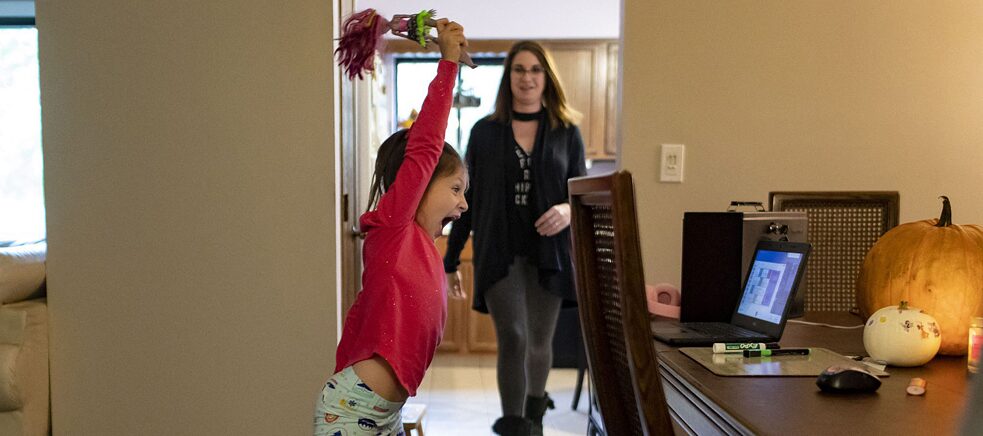Home Office
The Hybrid Generation

It isn’t just the big international tech corporations who are holding heated discussions about staff returning to the office in summer 2022. Plenty of employees would like to remain at home in Germany too: what makes the home office so attractive?
Tesla CEO Elon Musk caused commotion for his workforce in June 2022 by emphatically rejecting the home office. Google would also like to see employees back in the office at least three days a week. By contrast, Twitter boss Parag Agrawal is allowing complete freedom: colleagues there can decide for themselves where they work. After large-scale protests throughout the workforce, employees at Apple, Amazon and Microsoft can negotiate a hybrid working model directly with their bosses.
The earth’s moving in Silicon Valley, and the debate clearly shows how the workplace has changed as a result of Covid. According to a study conducted by the Pew Research Center in America back in 2020, 54 per cent of workers who were doing their jobs from home stated that they would like to continue to work there full or part-time even after the pandemic. In Germany a global study of the employment market was carried out by professional services consultancy PricewaterhouseCoopers (PwC) entitled “Hopes and Fears 2022”, which concluded that just five per cent of people who work from home would like to start commuting to the office every day again.
For good reason – in a survey in 2022 the US initiative Tracking Happiness discovered that having the ability to work remotely increases employee happiness by 20 per cent, and that was on a global scale: the respondents included people from North and South America, Asia and Europe.
Is working from home really better for employees?
An Opportunity for Inclusion
The home office can be a viable alternative, especially for people with disabilities. If someone is physically disabled, their own home will already be designed as a barrier-free environment and there is no need to commute, which would pose a challenge to people with impaired sight or mobility. Not only that, but a home office can reduce the risk of infection during a pandemic. People with mental health issues can also perceive their home to be the safe place they need in order to achieve their full productivity potential.
Philipp Kahn-Pauli, who works for a non-profit called RespectAbility, even observed a slight increase in inclusion of people with disabilities in the US employment market during the pandemic. “In March 2020 the employment rate for people with disabilities of employable age was just 34.9 per cent.” In May 2022 on the other hand it was 37.8 per cent. “This means that more people with disabilities are integrated into the employment market than before the pandemic.”
“Yet obviously inclusion can only be successful in the home office if barrier-free online access is provided as well,” points out Jonas Karpa, editor at Sozialheld*innen e.V. “Can everyone communicate effectively with each other? Are online tools easy to understand and accessible to everyone?” Furthermore it can make feelings of loneliness worse, not just for people with mental health issues. There is a risk of social isolation for deaf people as well as people with autism, for whom the workplace is often the only option to cultivate social contacts. And there is certainly the risk of employers pressuring people with disabilities to work from home: “Working from home must not be an excuse on behalf of the employer because their office is not designed as a barrier-free environment,” says Karpa.
Higher Energy Costs
Costs play a role too, if employees decide to work from home. According to energy provider EnBW, electricity bills can rise by up to 250 euros a year, incurred for instance through laptop or PC use, lighting and cooking. According to the Office for National Statistics, 86 per cent of those working from home in the UK said that their electricity, water and gas bills had gone up. Furthermore investments have to be made to outfit the home office properly. “New purchases such as an office chair, desk or monitors can quickly exceed a budget of 1000 euros,” says online marketing manager and home office expert Maximilian Kayser. The employers don’t always cover these costs.
No Travel Costs
Yet Kayser also sees potential savings: a high cost factor in the office is the daily food order, he says. This easily accounts for 10 euros every day, which you don’t need to spend at home. But probably the biggest share of avoidable costs is travel. “On average people in Germany who commute to work travel 34 kilometres each day to get to and from work,” Kayser has calculated. This amounts to a considerable sum of money, either for filling up with increasingly expensive fuel or for a monthly public transport ticket, and wear and tear on the car is a fraction of what it would be. Plus the fact that commuting less also has a positive effect on the environment as it means reduced emissions.
 Many employees state that they are better able to combine their jobs with their private lives in the home office. But at the same time the boundaries between leisure and working time often become blurred. | Photo (detail): © picture alliance/abaca/TNS/ABACA
Many employees state that they are better able to combine their jobs with their private lives in the home office. But at the same time the boundaries between leisure and working time often become blurred. | Photo (detail): © picture alliance/abaca/TNS/ABACA
Removing Boundaries Between Work and Family
According to a survey conducted by the Bitkom digital association, a large majority of the working population who work remotely feel less stressed and enjoy significant time savings, while many more value the flexible hours and better potential for combining work and private life. But at the same time, removing these boundaries is one of the huge dangers for health in the home office. Many employees tend to work longer hours than they do in the office – including for instance at night, when the children are asleep. Having your career and family under the same roof can easily lead to a blurring of the boundaries between work and private life. But it’s extremely important to draw a clear line between work and private life to ensure that home workers have enough time for relaxation. This applies in particular when employees are unwell, because if someone is working from home anyway they are easily tempted not to call in sick. A British study for instance found that in 2020, the first year of the pandemic, incidences of sick leave in England hit an all-time low of 1.8 per cent.
Proximity Bias: Out of Sight, Out of Mind?
Incidentally – the lack of face-to-face interaction with colleagues is the most frequently stated disadvantage of the home office, according to the Bitkom study. Reduced contact with the boss is a contributory factor here too, as identified in the “State of Hybrid Work 2022” survey of office workers in Germany by tech firm Owl Labs at the start of 2022. 44 per cent fear that something known as a “proximity bias” exists at their workplace – a psychological phenomenon according to which colleagues who are present in person at work are favoured by the boss due to their physical proximity. In fact, according to further results of the study, 53 per cent of bosses and 57 per cent of senior management are more likely to ask the opinion or engage with those they physically work with.
Generation Hybrid
While companies are still struggling with the implementation of hybrid work models, employees have a fairly clear idea of how they would like to work in the future. If it was left up to them, there would be a mix of remote and face-to-face work. What might that look like? Something like this: popular places to work include holiday accommodation, a shared desk at the office, a permanent place of residence abroad, and a co-working space. A third of those surveyed would even like to work from a camper van.